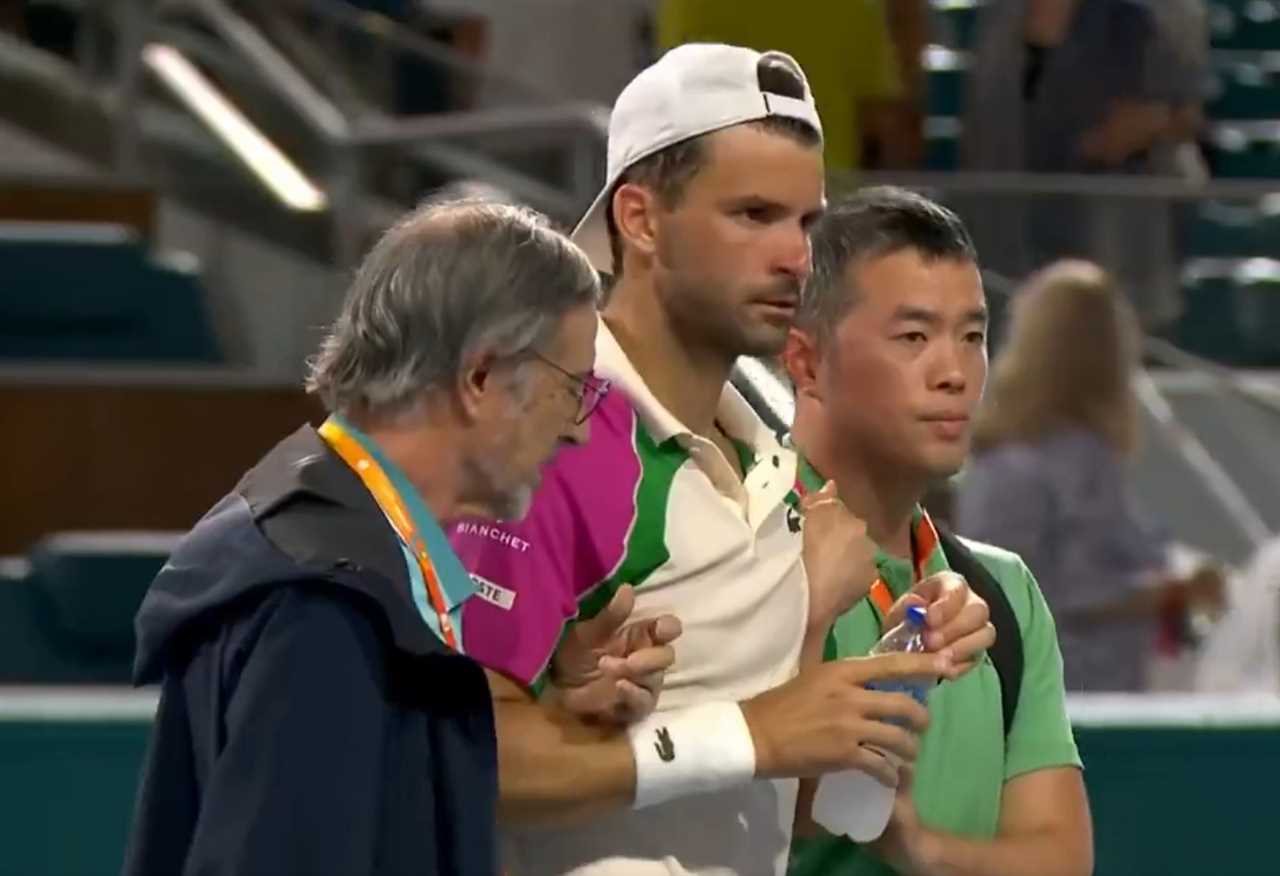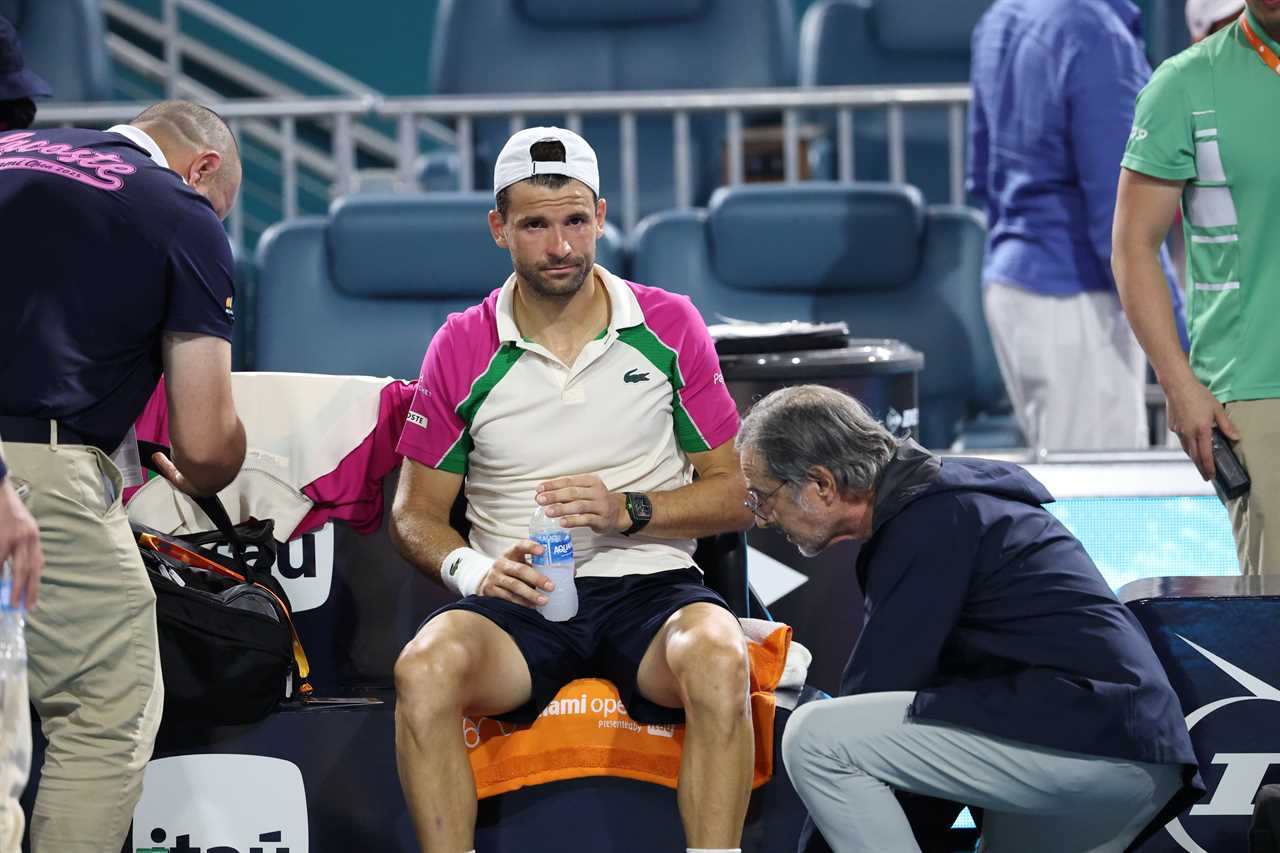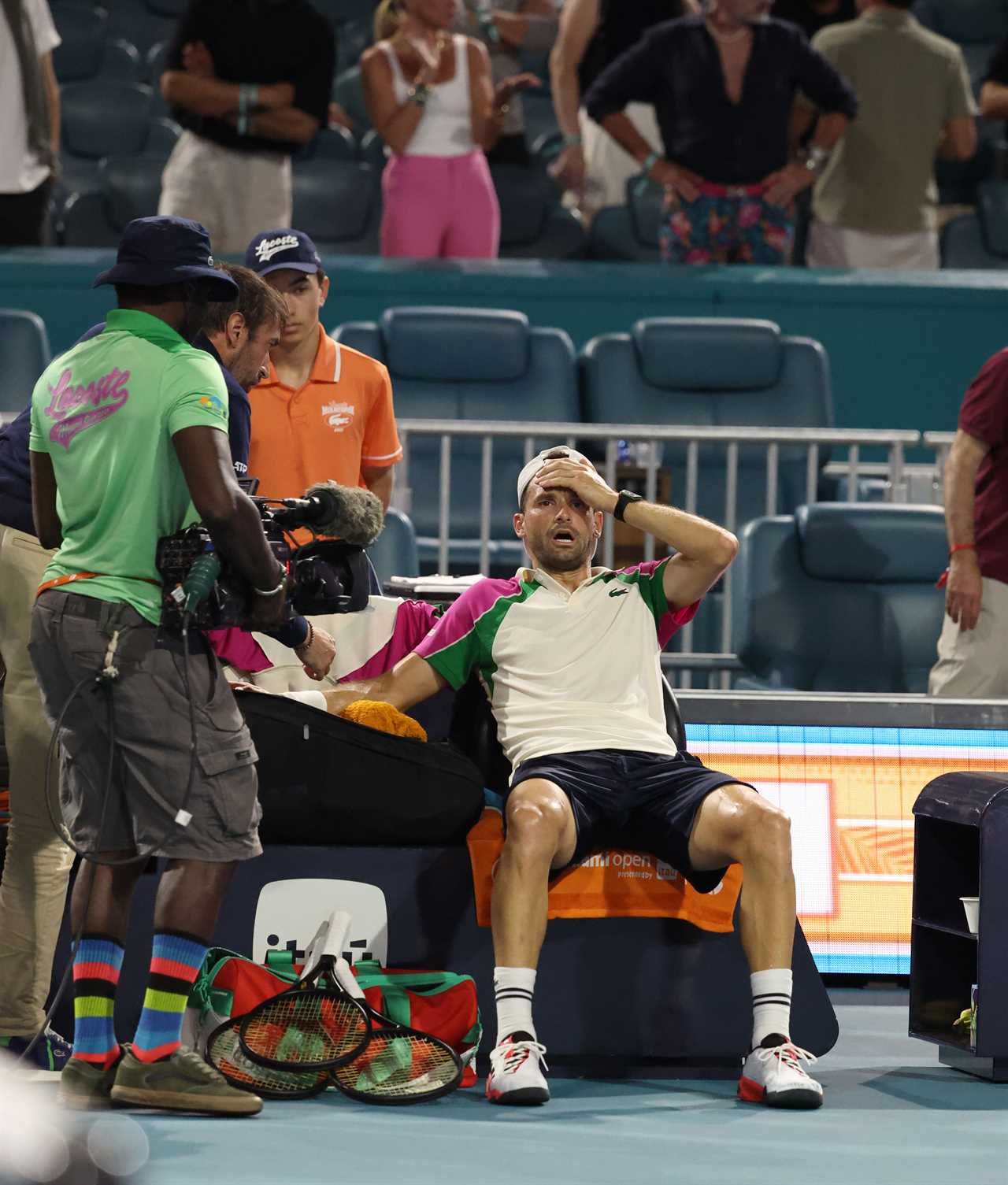
Dimitrov Triumphs Amidst Physical Strain
Grigor Dimitrov secured his spot in the semi-finals of the Miami Open after a tense quarter-final victory over Francisco Cerundolo. The match stretched nearly three hours, concluding at 2 hours and 48 minutes, with Dimitrov clinching the win in a nail-biting 6-7 (6), 6-4, 7-6 (3). Despite losing the first set in a tiebreak, the Bulgarian athlete showcased remarkable resilience by saving a match point in the final set, marking his 150th ATP Masters 1000 match win.
Health Scare After Victory
Celebrations were short-lived for Dimitrov as he was swiftly carried off the court post-match. The 33-year-old appeared to struggle with severe cramps and was visibly weakened, leading him to request medical attention after collapsing into his chair courtside. Medical staff promptly attended to him, checking his blood pressure and providing necessary care before assisting him off the playing surface. Dimitrov now faces a day of rest to recover from the intense physical exertion.
Raducanu's Campaign Cut Short
In parallel, Emma Raducanu’s impressive run in the tournament came to an unexpected end during her last-eight clash against Jessica Pegula. The 22-year-old British star faced a challenging match, ultimately falling 6-3, 6-7 (3), 6-2. Midway through the second set, Raducanu experienced a moment of dizziness that raised immediate concerns. Despite the discomfort, she received medical attention, including a blood test, and chose to continue playing, pushing through to complete the match.
Impact of Extreme Conditions
Reflecting on her experience, Raducanu attributed her physical distress to the high humidity and the demanding nature of the match. "I just felt really dizzy. I felt faint," she explained. "It was very humid out there and we had a long wait. Maybe just an accumulation, and just physical points as well with long rallies and heavy conditions." Her perseverance was commendable, but ultimately, the challenging weather and strenuous play took their toll.

Scheduling Hurdles Hit the Tournament
The drama extended beyond the players’ performances as the tournament faced scheduling issues. The anticipated semi-final showdown between Novak Djokovic and Sebastian Korda was put on hold after organizers ran out of time, leading to the postponement of Korda’s quarter-final match against Djokovic. ATP and WTA regulations stipulate that matches should not commence later than 11 PM local time without special permission, adding to the logistical challenges faced by the Miami Open organizers.
Martina Navratilova Weighs In
Legendary tennis figure Martina Navratilova commented on Dimitrov's unexpected collapse, stating, "I’ve never seen a player collapse after the match they have won." Her surprise underscores the severity of Dimitrov’s condition following his hard-fought victory. Navratilova's observation highlights the physical demands placed on today's athletes, especially in high-stakes tournaments like the Miami Open.
Looking Ahead to the Semi-Finals
With Dimitrov advancing to the semi-finals, he is set to face either Novak Djokovic or Sebastian Korda, depending on the outcome of the rescheduled matches. Fans eagerly await the next rounds, hoping for thrilling encounters despite the tournament's recent setbacks. Both Dimitrov and Raducanu have demonstrated incredible determination, even as they navigate the intense pressures and physical challenges of top-level tennis.
Conclusion
The Miami Open has proven to be a stage not just for exceptional tennis but also for the athletes' endurance and resilience under extreme conditions. As players like Grigor Dimitrov and Emma Raducanu push their limits, the tournament continues to captivate audiences with its blend of high-stakes competition and human drama. As the semi-finals approach, spectators remain hopeful for more exhilarating matches and triumphant performances.

Frequently Asked Questions
How important is it to compete in junior tournaments for a career in professional tennis?
The junior tennis tournament is an important step towards a professional career in tennis. These tournaments allow young athletes to practice their skills and gain match experience against other players. They also help them to learn how to handle the pressure of competition. Junior tournaments are also a great way to prepare for higher-level competitions. They can have a significant impact on a players ranking, their visibility to sponsors and coaches, and even how they develop as a person.
How can a tennis player balance school and intense training requirements?
Balance between academic obligations and intensive training schedules can be difficult for aspiring players. Time management, prioritization skills and sometimes creative scheduling are required. Online schooling programs and flexible academic schedules can help young athletes manage their training and travelling schedules. Support from family, coaches, and educational institutions also plays a crucial role in ensuring players can pursue their athletic ambitions without compromising their education.
What is the importance of nutrition and diet for a tennis athlete?
Tennis players, like all athletes who want to reach the top of their game, need proper nutrition and diet. The right diet supports intense training by providing energy, improving recovery and reducing injury risks. Diets of elite athletes typically include a balance of carbohydrates, protein, and fats as well as essential vitamins and minerals. The importance of hydration cannot be overstated, as a healthy fluid balance is vital to maintain concentration and prevent fatigue.
Can someone begin playing tennis late, and still be a professional?
Tennis is a sport that can be played at any age. While it will require more effort, you can still reach professional status. Success depends on an individual's athletic abilities, work ethic, commitment, and accessing quality coaching and competitive opportunities. Late starters may need to undergo intensive, focused training. Although the road is more difficult, with talent and persistence, it's possible to reach a professional level.
What role does video analysis play in training top tennis players?
Video analysis is an essential tool in the training and development of top tennis players. It is a great tool for reviewing technique, tactics and patterns of opponents. Video analysis allows coaches and players alike to review strokes in detail, identify areas for improvement, strategize and plan against future opponents. It can also help to recognize habits and patterns that are often overlooked in the heat of competition. This allows for more effective and focused practice sessions.
Statistics
- Statistical trends indicate that top tennis players usually have at least 5 people in their support team, including coaches, fitness trainers, and physiotherapists.
- Nutritionists report that a tennis player's diet should consist of about 55-60% carbohydrates, 15-20% protein, and 20-25% fats during intense training periods.
- Approximately 70% of a professional tennis player's training time is devoted to developing technique and on-court strategies.
- Studies show that superior agility and speed among tennis players can reduce their reaction time by up to 30%, which is crucial during high-level matches.
- Persistent mental training and sports psychology can help reduce performance anxiety by up to 60%, according to sports psychologists working with elite athletes.
External Links
How To
Tennis Training: Optimize your schedule
Tennis training must be balanced between fitness training, on-court practice and match play. To begin, allocate blocks of time to developing your technical skills, such as groundstrokes and serves, and understanding tactics through scenario drills. Each week, include sessions in speed, endurance and strength to develop a complete fitness base. Play at least one match per week to allow you to test your skills in an intense competitive environment. Introduce rest days after intense training or match-play to promote recovery. A regular review of your training plan is necessary to keep up with the latest developments.
 CricketBoxingFormula 1GolfHorse RacingPremier LeagueTennisPrivacy PolicyTerms And Conditions
CricketBoxingFormula 1GolfHorse RacingPremier LeagueTennisPrivacy PolicyTerms And Conditions
